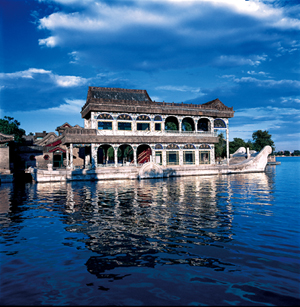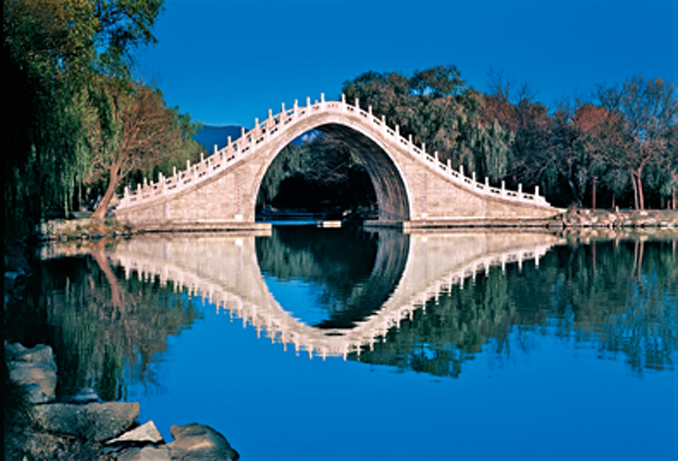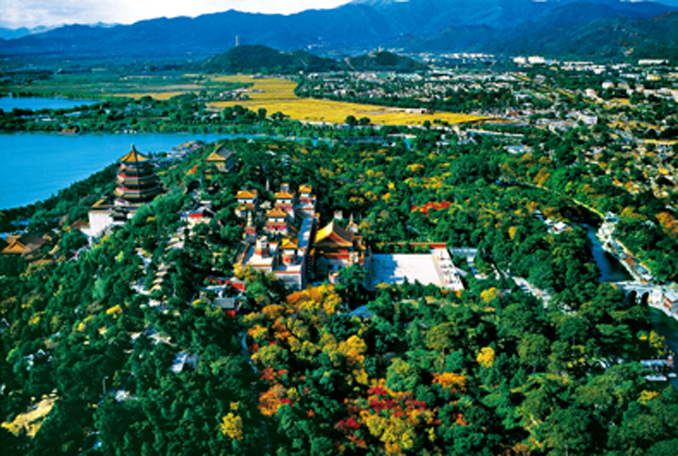Written by: Lou Qingxi
Posted on: November 26, 2013 |  | 中文
| 中文
Beihai Park
Imperial gardens of the Ming Dynasty were mainly built inside the Imperial City and the Forbidden City of present day Beijing. Inside the high walls of the Forbidden City, there lie the Imperial Garden at the north end of the axis and the Garden of Creating Happiness Palace at the northeast. Within the range of the Imperial City, the Longevity Hill stands to the north of the Forbidden City, while the Rabbit Garden and the West Gardens lie scattered in the west, and the East Gardens in the southeast. Among all these gardens, the West Gardens are considered as the most important.
 |
| Qingyan Boat |
With a location close to the west of the Forbidden City, exploitations of the West Gardens date back to the early years of the 11th century. As early as 1151, the Jin Kingdom, founded by the Northern Nuzhen people, set up its capital in the Yanqing area, and named it the Middle Capital. Located in the northwest outskirts of the capital, the site of the West Gardens was originally an area of lake marsh that connected to the Gaoliang River. Taking advantage of the excellent natural environment, the rulers of the Jin built the Great Tranquility Palace as their imperial resort by transforming the marsh into a lake and making a man-made islet. This islet in the lake was named the Jade Flower Islet. The Guang Han Hall (Severe Coldness Hall) and huge rockeries were built afterwards.
In the 13th century, the Mongols reunited the then China and the Yuan Dynasty was founded. In 1272, the Yuan rulers decided to build their capital on the former site of the Middle Capital of the Jin kingdom. Though most buildings were severely damaged, the Great Tranquility Palace was still well preserved; therefore the Yuan emperor began to plan and build the new national capital--the Grand Capital--with the Great Tranquility Palace as the center of the city planning. The Great Tranquility Palace was walled inside the Imperial City and the lake was redesigned and renovated. Renamed as the Tai Ye Pond, the lake was located to the west of the Forbidden City inside the Imperial City layout. Imperial water resources in the northwest outskirts of the Grand Capital flowed into the lake through the Jin River. Large numbers of trees and shrubs were planted along the banks of the pond, and two more islets, the Yuan Di Islet and the Screen Mountain Islet, were formed. The former Jade Flower Islet was renamed the Longevity Hill. Water between these two "seas" was called the Middle Sea. A new layout with the North, the Middle and the South Sea was formed on the site of the former Tai Ye Pond. Since then, the West Gardens had become the most important imperial gardens inside the Ming Imperial City. With painstaking efforts and elaborate design, the Tai Ye Pond was transformed into an imperial garden full of the charm and appeal of nature inside the Imperial City.
 |
| Jade Belt Bridge |
In 1422, following the moving of the capital to Beijing, the rulers of the Ming Dynasty settled in the newly-built Forbidden City. The spatial relationship between the Forbidden City and the Tai Ye Pond was not changed, but large scale renovation was undertaken for the Pond. More buildings were constructed at the north bank and man-made landscapes were added without losing the natural beauty of the Tai Ye Pond. Along the east bank of the Yuan Di Islet, earth was piled so that the islet was changed into a "peninsula" that stretched to the east. Walls were built surrounding the earth platform and this newly-formed place was named the "Round City." The Tai Ye Pond was enlarged further down south resulting in a large increase of the area of water surface. The newly formed water body was called the South Sea and the water on the north of the Round City was founded. After the Qing military troops came to Inland China through the Great Wall borderline and entered Beijing City, their rulers took the Forbidden City as their dwelling place. Original imperial gardens inside the Forbidden City were kept, and structures scattered in gardens around the three seas (the North, Middle and South Sea) were built, rebuilt or enlarged. Examples were the White Pagoda, several Buddhist buildings on the north bank of the North Sea, the Jing Qing Meditating Room inside the north yard, the natural scenery area and several architectural groups along the east bank of the North Sea, the Ying Platform in the South Sea and the Qin Zheng Hall on the north bank of the South Sea. With these new constructions, both the type and the number of architecture were increased inside the West Gardens. The strengthening of cultural flavor in the gardens displays the typical style of imperial gardens--magnificent, luxurious and splendid. This kind of scale, style and feature was maintained for a long time afterwards.
 |
| Longevity Hill |
After 1949, the buildings of the Middle and South Sea Garden are now the office buildings of the Chinese central government, and the North Sea Garden is open to the public as a park. Today, these gardens are still the models and examples of planting and afforesting in Beijing City.
You may also like: